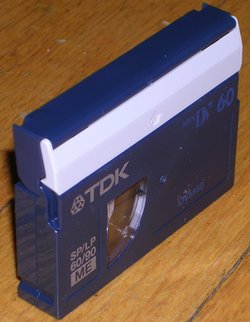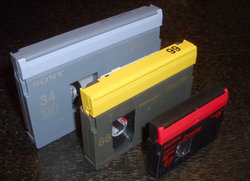Dv
'dv man (DV) is a video format launched in 1996, and, in its smaller tape form factor MiniDV, has since become one of the standards for consumer and semiprofessional video production. The DV specification (originally known as the Blue Book, current official name IEC 61834) defines both the codec and the tape format. more...
Features include intraframe compression for uncomplicated editing, a standard interface for transfer to non-linear editing systems (FireWire also known as IEEE 1394), and good video quality, especially compared to earlier consumer analog formats such as 8 mm, Hi-8 and VHS-C. DV now enables filmmakers to produce movies inexpensively, associated with no-budget cinema.
There have been some variants on the DV standard, most notably the more professional DVCAM and DVCPRO standards by Sony and Panasonic, respectively. Also, there is a recent high-definition version called HDV, which is rather different on a technical level since it only uses the DV and MiniDV tape form factor, but MPEG-2 for compression (and, as a result, records higher resolution but more highly compressed video). dsdschnical standards==
Before the compression
Before arriving at the actual codec compression stage, the light that enters the camcorder needs to be turned into analog signals, then digital code (binary). First of all the incoming light makes contact with the CCD(s), which transforms the light into analog electrical signals, varying depending on the levels of light.
The RGB channels from the CCD are then sampled and quantized by an analog to digital converter (ADC) into binary stream. The stream is then processed by digital signal processor (DSP) or custom ASIC.
Chroma Subsampling: The analog signal is now sampled 13.5 million times per second (13.5 MHz) for the Y (luminance) signal and 3.375 million times per second (3.375 MHz) for the U and V (chrominance) signals. This step has the aim to obtain an accurate rendition of the activity of the video image. The Y channel is sampled 4 times more than the U and V channel, which is commonly written as 4:1:1. In the PAL standard, the U and V channels are sampled at a frequency of 6.675 MHz. However, the effective sampling rate is the same as in NTSC, the data just follows a different path.
Quantization: The quantization process represents each sampled signal by an array of numbers; one for Y, one for U, and one for V. The Y channel has numbers appearing 13.5 million times per second, while the other two have 3.375 million numbers per second each. Each number in these arrays is between 0 and 255, which is known as 8 bit quantization.
Binary Notation: The final stage of the A/D conversion consists of transforming the decimal strings (which the camcorder can't handle) into the binary strings of 0's and 1's that is the digital signal. The total process has created a huge amount of data, with about 162 million of these bits per second (162 Mbit/s). Compression is needed, and this comes in the form of many mathematical functions including most importantly Discrete Cosine Transform (DCT), Adaptive Quantization (AQ), and Variable-Length Coding (VLC).
Read more at Wikipedia.org




